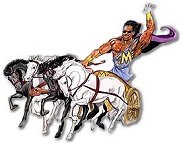|

THANATOS & HYPNOS CARRYING SARPEDON
Thanatos was the god or personification of
Death, the son of Nyx (Night) and twin brother to Hypnos
(Sleep). He had no father as Nyx bore him alone. He mostly
operated under the command of Hades, feared god of the
Underworld.
He appeared to humans to carry them off to the Underworld when
the time allotted them by the Fates had expired. That task was
sometimes assigned to the Olympian messenger god Hermes.
Thanatos was a minor figure in Greek mythology, mentioned often
but rarely appearing in person. Besides his twin Hypnos, he had
a large number of siblings courtesy of Nyx, many with negative
personifications.
These siblings included Nemesis (Retribution), the Stygian
boatman to the Underworld called Charon, Geras (Old Age), Oizys
(Suffering), Apate (Deception), Moros (Doom), Momus (Blame),
Eris (Strife) and the three Fates, particularly Atropos, herself
a goddess of Death.
Thanatos represented non-violent death, with a touch as gentle
as his twin brother Hypnos. His blood-craving sisters, the
fearsome Keres, were responsible for violent death, being
dreaded spirits of slaughter and disease.
Thanatos was depicted in ancient vase painting as a winged,
bearded old man, or less often as a beardless youth. Both he and
his brother Hypnos were often portrayed as slumbering youth.
In a scene from Homer's Iliad, he is shown along with
Hypnos carrying off the body of the Greek hero Sarpedon, who had
been slain by Patroclus on the battlefield, transporting him to
the country of the Lycians to receive proper burial. They did so
on the orders of Zeus, King of the Olympians, and the command
was delivered by Apollo.

THANATOS, HYPNOS, HERMES & SARPEDON
Even though Thanatos yielded terrific influence, often merciless
and indiscriminate - both towards mortals and gods - some
managed to outwit him.
King Sisyphus of Corinth pulled this off twice. Sentenced to the
depths of Tartarus by Zeus and ordered to die, sly Sisyphus
tricked Thanatos by having him model the handcuffs with which he
was to be chained. Out of commission, Thanatos was unable to
perform his godly duties, causing no mortal to die while he was
shackled.
It didn't take long for Ares, the bloodthirsty god of war, to
grow livid because, in all the battles he incited, neither side
could suffer any casualties. Ares released Thanatos and
delivered Sisyphus to him.
A second time Sisyphus convinced Persephone, goddess of the
Underworld, to permit him to return home to his wife so that she
could give him a proper funeral, having no intention to ever
return. Hermes located Sisyphus and forcefully dragged him back
to the Underworld. There, he was sentenced to an eternity of
frustration in Tartarus, made to roll a huge rock up a hill,
only to have it roll back over him just as he got to the top.
Another time the great hero Heracles (Hercules) wrestled with
Thanatos in an effort to retrieve a gentle woman named Alcestis
from Death. He did this on behalf of King Admetus, who was
mourning her loss. Successfully defeating Thanatos, Heracles
presented Alcestis to her disbelieving husband.
The Romans portrayed him as a young man holding an upside down
torch (to represent the extinguishing of a life) and wreath of
poppies, or a butterfly, which was used to symbolize the souls
of the dead.
Thanatos was often described as winged, with a sword sheathed at
his belt. Rarely was he depicted without his twin brother
Hypnos. Even though there are a few references to sacrifices
being offered to Thanatos, only one temple in his honour is
ever mentioned.


BACK HOME

|







